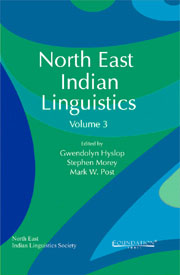Book contents
- Frontmatter
- Contents
- About the Contributors
- Foreword
- A Note from the Editors
- The View from Manipur
- The Sal Group
- Tibeto-Burman Nominalization
- Tani
- Eastern Indo-Aryan
- 11 The Referring Systems and the Determinative Elements of Noun Phrases in Assamese
- 12 Copular Sentences in Asamiya
- 13 Case Marking in Hajong
- Austroasiatic
11 - The Referring Systems and the Determinative Elements of Noun Phrases in Assamese
from Eastern Indo-Aryan
Published online by Cambridge University Press: 26 October 2011
- Frontmatter
- Contents
- About the Contributors
- Foreword
- A Note from the Editors
- The View from Manipur
- The Sal Group
- Tibeto-Burman Nominalization
- Tani
- Eastern Indo-Aryan
- 11 The Referring Systems and the Determinative Elements of Noun Phrases in Assamese
- 12 Copular Sentences in Asamiya
- 13 Case Marking in Hajong
- Austroasiatic
Summary
Introduction
Along with number, gender and case, nouns in Assamese and all other Indo-European languages have another important grammatical category, the discussion of which was not found in traditional grammars of olden days of east or west. Nouns, especially class nouns, need to be determined by some devices when they are used in sentences to realize any argument – subject, object or complement. The noun man in English or manuh in Assamese, for example, can refer to all the human beings in one use and in another use the reference of the same noun can be restricted to only one person. The reference of the noun man in former use is called generic and in later the reference is said to be of specific. The specific reference of a class noun can be again definite or indefinite.
One of the reasons behind the absence of discussion on the determinative elements of nouns in traditional grammar may be the absence of a definite article in the older Germanic languages in the west (Hawkins 1978: 13) and any such element in Old and Middle Indo-Aryan Languages in the east (Kakati 1972: 278) to show contrast between definiteness and indefiniteness of NPs. In modern linguistics, however, this feature has been studied by scholars from many different backgrounds and perspectives. Traditional grammarians (Christopherson 1939; Jespersen 1949), philologists (Heinrichs 1954; Hodler 1954), structuralists (Yotsukura 1970), transformational syntacticians (Smith 1964; Higham 1972), and philosophers and logicians (Russell 1905; Strawson 1950) have all contributed to the currently available data and descriptive insights.
- Type
- Chapter
- Information
- North East Indian Linguistics , pp. 173 - 196Publisher: Foundation BooksPrint publication year: 2011
- 1
- Cited by

